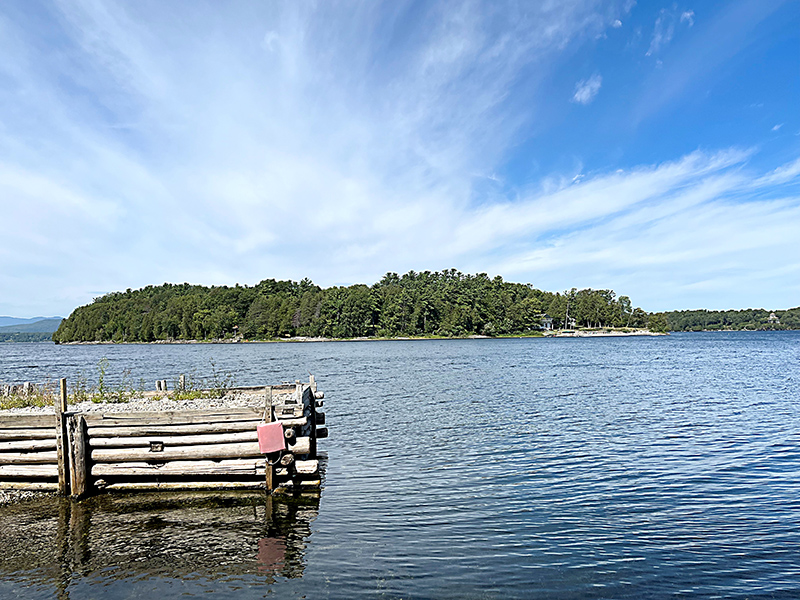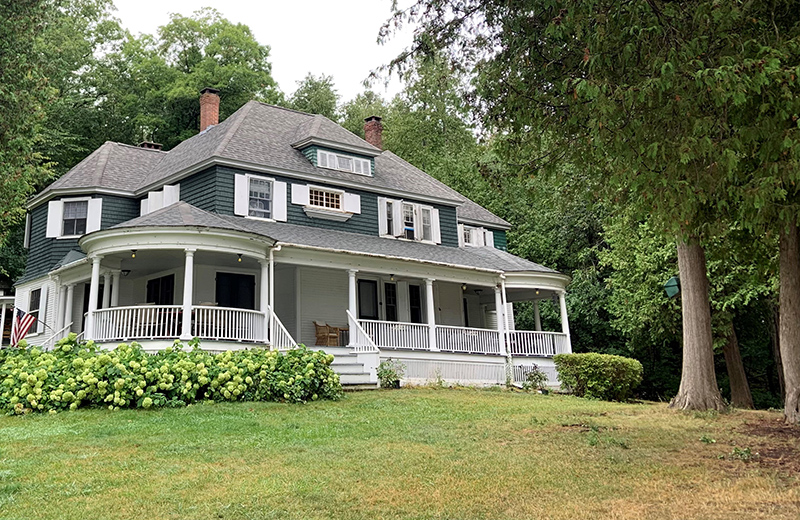The island that time forgot
The pontoon boat-ferry takes about 11 minutes to make the quarter-mile crossing from the cement dock at the foot of Deer Point Road in Charlotte to the island in Converse Bay. Stepping ashore on Garden Island, however, you’d swear you’ve traveled back in time, a half-century or more.
“Yep, it’s always 1950 here,” says a beaming James (Jim) Brown. And that’s the way he likes it.
Standing in the gazebo a short walk from the island dock, Brown sweeps a long arm across the vista. “Hit me right away — it’s special,” he exclaims.

With his brother and another partner he has owned the island since 1975. Their friends and families have joined the Browns here every summer since — as have other folks who’ve rented one of the six cottages open to the public.
Though privately owned this is no luxury hideaway such as those Xanadus acquired by Richard Branson or Sting. Strip away the billion-dollar views, move the cottages inland and Garden Island registers as genteel rustic. But Lake Champlain confers a sense of isolation and singularity, so the place feels authentic and a kind of throwback to Eisenhower-era innocence, of TV shows like Leave it to Beaver and Father Knows Best. A simpler time, emphasized by the absence of television. And that, too, is the way Jim Brown likes it.
For such an itty-bitty isle — 32 acres, soaking wet — Garden Island punches way above its weight in colorful history. It has hosted U.S. presidents, the rich and famous and the Vermont-famous. Ownership has changed hands more often than a blackjack dealer and its market value has grown exponentially.
Garden Island has even produced a landmark legal case that is required study at law schools everywhere. And by its very nature of being privately owned but publicly accessible, beloved and sometimes begrudged, a part of Charlotte but prized for its separation, it carries an outsized mystique.
So … you make a call. A boat comes to fetch you and, to hear Brown say it, you’re truly away from it all.
“The adventure of coming here, it starts when you step on the boat,” says Brown. “These are 1950s-style camps. No television, no video games. I call it back to a better time. People who come here know what to expect. If you don’t like water this is probably not the place for you.”
Charlotte residents Elizabeth Bassett and husband John Pane first rented a cottage for a week about a decade ago. They doubled their length of stay the next year and now spend five weeks of their summer on Garden Island. Bassett calls it “our summer camp without ownership.”
“We bring our kayaks and paddle whenever the mood strikes,” Bassett explains. “Our little grands love the beach and are graduating to kayaks and paddle boards. We love hosting our local friends who arrive by personal craft or ferry for potluck gatherings.”

Brown recalls a family —kids, parents, grandparents —who came one summer and seemed to relish the experience. When they were leaving, the grandparents said something like, “that was very nice; maybe next summer we’ll go to Disneyworld.” The kids looked at each other, Brown says, “and then they said, no, we’d rather come back here, to the island.”
Thanks to the ignorance of 18th century cartographers, Garden Island literally popped up out of nowhere. Charlotte was incorporated in 1762, but the island is not visible on a map drawn the following year. Almost a century later, in 1857, it appears, nameless, like Atlantis rising from the sea. Two years later it is marked as “Birch Island” and deeded to a Mr. J. Holmes.
The island’s profile changed dramatically in 1887 when a well-heeled yachtsman named Henry W. Putnam Jr. paid $2,000 for a place to go ashore when he wasn’t racing his sloops around Lake Champlain. Putnam made some serious improvements to the heavily wooded island, building the elegant Maple House so he could entertain his fellow sailors and famous landlubbers. In 1897, during a visit to the region, President William McKinley took a cruise on Putnam’s pride, his 103-foot-long steam yacht Washita. “The party was taken to Mr. Putnam’s Island, opposite the village of Essex, where an elaborate luncheon was served,” according to a local newspaper account.
President William Howard Taft is also said to have visited Putnam but the documentation is elusive. True believers cite the presence of an oversized bathtub in Maple but a recent visitor surmised the tub might have accommodated the 27th president’s 6-foot, 340-pound bulk — but not enough water to make him damp.
It was during Putnam’s stewardship that Garden Island rose to immortality — at least for law school students. The case was triggered by a family called Ploof, a group of landless vagrants eking out a living on the water through trade and theft, according to various accounts. In 1904, Sylvester Ploof was piloting his family in a heavily laden sloop across the lake when a storm blew up. Ploof sought refuge and tied up to Putnam’s dock. Seeing the interlopers as trespassers, a caretaker freed the vessel, leaving it to be dashed against the rocks and causing damage to the sloop and its contents, human and mercantile.
When the litigation smoke cleared, the Vermont Supreme Court ruled that Ploof should have been allowed temporary refuge out of necessity. Thanks to a freak storm, law students are well-versed in the tort law implications of Ploof v. Putnam. The case is also well-known among Vermont’s lakeshore communities.
In the early 1920s, Putnam sold Garden Island to a group from Bennington led by Adelbert Braisted, Putnam’s personal secretary. In 1944, John H. Patrick, owner of Deer Point —then and now the embarkation point for island visitors — assumed ownership.
Three years later, Patrick sold the island to Dr. David M Bosworth, an orthopedic surgeon. Neglect had caused Garden Island to wilt; the Bosworths made it bloom again. They installed water, electric and sewage systems and other conveniences in the six cottages and the island soon became favored as a family resort.
In 1973, a two-line New York Times ad for the sale of the island caught the eye of businessman James R. Brown. He drove up to Charlotte in early spring, borrowed a rowboat and made his way through the ice-pocked bay to the island. Within a very short time he used the island’s single landline to call his brother, Robert. “Bob, you should come up here.” The Browns paid Bosworth $150,000 and took possession in 1975.
Many visitors to the island are hooked once they visit, so demand is high and supply is six cottages: Maple, Birch, Pine, Cedar, Willow, Oak. Rents range from approximately $400 a night to $1,100 for Maple, which has six bedrooms and is available when the Brown family is not in residence. Wi-Fi, a relatively recent amenity, is available in all cabins.
The no-frills, no thrills vibe can soothe even Type A+ personalities, says Brown. He often tells visitors about the week a surgeon and an airline pilot were guests. They didn’t know each other but after three days of pacing the beach, the pair bonded and just sat for hours at the edge of the lake.
In 2010, surprisingly, the Browns put the island up for sale at $7.9 million. Jim says it resulted from an inquiry from an interested buyer and the listing just happened.
“It took on a life of its own,” Brown maintains, as if it was spontaneous combustion. “Somebody made us an offer, we put it up for sale and then we took it off.” At the time, real estate agents reported inquiries from at least eight parties but no firm offers.
Perhaps some would-be buyers were not fans of the 1950s, or yearned to have their Teslas handy — despite the lack of roads. “We provide a launch service that we call a ferry,” says Brown. “We’ve had a number of people who go to the ferry dock in Charlotte and they call me to complain — ‘The captain won’t take me to the island.’ I say, ‘Are you at the ferry with the cars?’”
A phone call summons Carl, who is piloting the pontoon boat for the trip back to the mainland. He’s been doing this for seven summers; in the winters he works at the Killington Ski Resort. He likes this gig — small talk for a short sail.
Garden Island is a 32-acre swatch of dry land in the vast watery expanse of Lake Champlain — sitting within swimming distance of the shoreline and yet — admit it — how many of you didn’t know it existed? And then consider that folks who’ve made the brief crossing to the island say they will never forget it.

